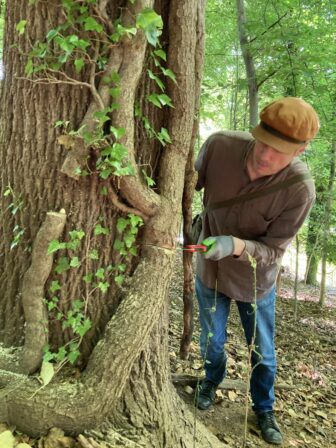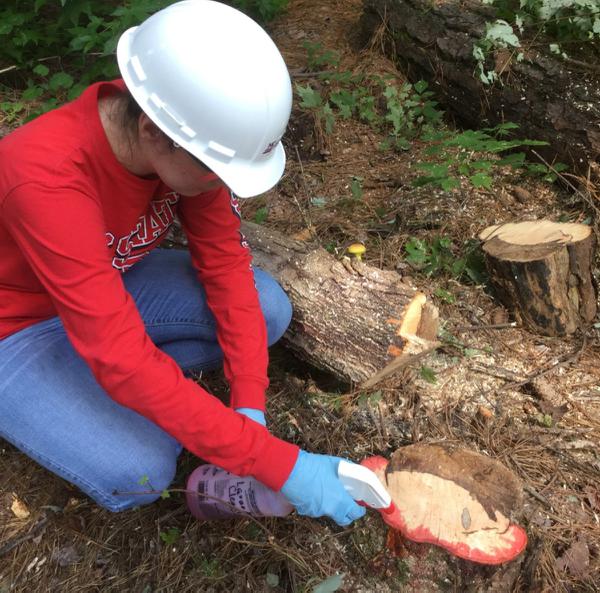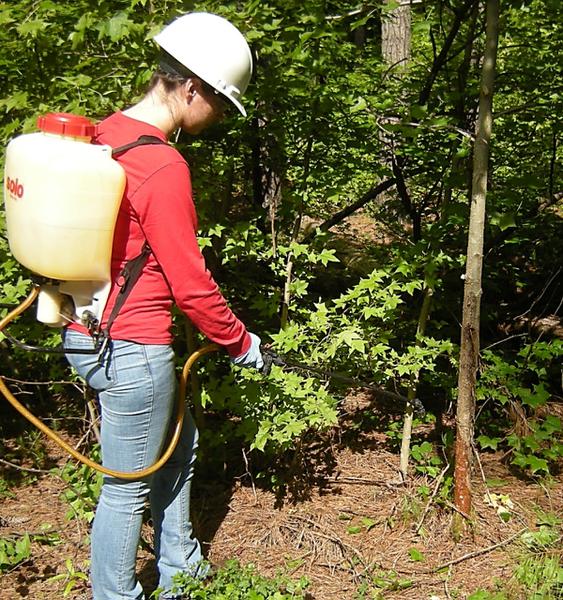Invasive Plant Management: Forming a Game Plan After Helene
go.ncsu.edu/readext?1063930
en Español / em Português
El inglés es el idioma de control de esta página. En la medida en que haya algún conflicto entre la traducción al inglés y la traducción, el inglés prevalece.
Al hacer clic en el enlace de traducción se activa un servicio de traducción gratuito para convertir la página al español. Al igual que con cualquier traducción por Internet, la conversión no es sensible al contexto y puede que no traduzca el texto en su significado original. NC State Extension no garantiza la exactitud del texto traducido. Por favor, tenga en cuenta que algunas aplicaciones y/o servicios pueden no funcionar como se espera cuando se traducen.
Português
Inglês é o idioma de controle desta página. Na medida que haja algum conflito entre o texto original em Inglês e a tradução, o Inglês prevalece.
Ao clicar no link de tradução, um serviço gratuito de tradução será ativado para converter a página para o Português. Como em qualquer tradução pela internet, a conversão não é sensivel ao contexto e pode não ocorrer a tradução para o significado orginal. O serviço de Extensão da Carolina do Norte (NC State Extension) não garante a exatidão do texto traduzido. Por favor, observe que algumas funções ou serviços podem não funcionar como esperado após a tradução.
English
English is the controlling language of this page. To the extent there is any conflict between the English text and the translation, English controls.
Clicking on the translation link activates a free translation service to convert the page to Spanish. As with any Internet translation, the conversion is not context-sensitive and may not translate the text to its original meaning. NC State Extension does not guarantee the accuracy of the translated text. Please note that some applications and/or services may not function as expected when translated.
Collapse ▲Invasive plants are defined as being non-native in the ecosystem they are found in, and their introduction can cause economic, environmental, or health concerns. One of the long-term impacts of recent damage due to Helene, is the potential spread of invasive plants in the landscape. Invasive plants are more likely to gain a foothold in our area if there is exposed ground, and events such as recent flooding and wind damage can spread these plants throughout the landscape. The negative impacts are easy to see, including displacement of native species in the ecosystem at large, and displacing desired plants in the garden. Hurricane Helene drastically altered the landscape and eroded streambanks, fields, and yards while also depositing soil that can contain invasive plant seeds resulting in an increase in distribution and spread of the invasive plant population. It is important now more than ever to know which invasive plants to keep your eye out for, and what you can do to manage these invasive plants to prevent their establishment in your landscape, and in our community at large. Coming up with a IPM plan (Integrated Pest Management plan) will be critical to holistically address this threat to our area.
Erosion and Open Canopy: Aftermath of Helene
Exposed ground due to erosion from flooding, or fallen trees/other vegetation can be an opening that invasive plants take advantage of. If you have ground that has been newly exposed, cover crops or selectively choosing those plants that naturally fill in those spaces, will be critical in preventing invasive plant establishment. There are special considerations for stream bank erosion which can be found here, and you can also utilize the cover crop selector tool as well to determine what options you might have. Native grass establishment with fescue blends can be conducted in the fall. You can also monitor the site and know which plants are invasive and selectively pruning/removing out problematic invasive plants while cultivating native vegetation. Regardless, identification of invasive plants is critical in stopping establishment in our community as a whole.
Importance of Monitoring:
So how do you know what to look for in invasive plants? Begin to look for plant characteristics such as leaf orientation, plant habit, and flowers/fruit that might form to properly identify potentially invasive plants. Over the next few months, I will be posting invasive plant BOLO’s and management strategy factsheets to address some of the invasive plant threats. You can visit the NC Invasive Plant Council list for WNC for a list of invasive species that are a threat in the mountains. If you have any questions about invasive plant identification, please reach out to your local N.C. Cooperative Extension office and we would be happy to assist you.
Now that I know what it is, what are my control options?
Once you have been able to identify the invasive species, what management strategies exist to prevent invasive plant spread? There are three main forms of control that we will discuss today that should be considered in your invasive plant management gameplan:
Cultural Control: Maintaining healthy plant establishment and desirable ground cover is the best way to prevent establishment of invasive plants. For newly eroded areas, we have discussed the impact cover crops can have already, but also consider mulching or encouraging native successional plants to cover the ground thereby preventing opportunities for invasive plant establishment. By limiting the opportunities for invasive plants to establish themselves from the get-go, we set ourselves up in the long run to prevent them from becoming an entrenched issue.
Mechanical Control: It is important to know the biology of the plant in question. When does the invasive plant flower and set seeds? When is the optimum time to control a particular invasive plant? These questions can be answered often times by looking a the biology of the plant itself. Plants can be more susceptible to specific treatments at certain times of their life cycle. Some plants are more susceptible to herbicide foliar treatment if they are actively growing, and flush cuts can be a viable method to generate susceptible growth to foliar herbicide treatment for certain invasive plants.
Knowing how a plant spreads can also inform us of strategies that we have in our arsenal to prevent spread to begin with. For example, when looking at Japanese stiltgrass, it is a prolific seeder (if left to flower, it can produce up to 50,000 seeds per square foot). If we know that it sets seeds by the end of August, then mowing before seed set could be a strategy to prevent overall spread to other areas while coupling that with an herbicide spray to better penetrate the newly cut stiltgrass in question. Window cutting is another example of a great mechanical strategy against woody invasive vines on trees. The idea is to cut off water and food to the above ground portions of the plant. This is often paired with painting an herbicide on the bottom portion of the vine to kill the root system. See the photo below:

Window cutting method on woody invasive vine.
Photo credit: Chesapeake Climate Action Network
https://chesapeakeclimate.org/learn-how-to-remove-invasive-vines/
Chemical Control: As part of any IPM plan, chemical options can be a useful tool if used appropriately and safely. With any herbicide, it is important to always follow label language to know how to utilize the product safely to protect yourself, those around you, and the environment. Be sure you know that the chemical is labeled for the correct use site, and is labeled to control the plant in question. Be aware of products that require a pesticide license (look for restricted use at the top of the label) and make sure that you have the appropriate license for the product including the use site where you are applying the product.
We have already mentioned the importance of biology of invasive plants and how specific development stages within a plant’s life cycle can help determine the optimum time to treat. The method of how we apply chemical controls can also determine how successful we are at controlling invasive plants. For many of our woody invasive plants, the cut and paint method is one of the best treatment methods we can utilize. The timing of this cut and spray method can be critical. For some invasive plants, the best time to do the cut and paint method is in the fall when plants are naturally pulling resources back into their roots as they go dormant, and for others it can happen throughout the year.

Cut stump and paint method.
Photo credit: Accomplishing Forest Stewardship with Hand Applied Herbicides-NCSU Extension
https://content.ces.ncsu.edu/accomplishing-forest-stewardship-with-hand-applied-herbicides
For example, with Kudzu, as the vine actively grows throughout the growing season, the cuticle on the leaf becomes thicker making herbicide applications less effective. Therefore, because we know this, the best time to treat Kudzu foliarly with a herbicide is in the early growing season or by using a flush cut method to promote fresh growth to then treat with herbicide. Foliar herbicide applications are typically done on younger growth. Other cut methods include the basal bark application for woody shrub and tree material that focuses on coating the bark in a band-like pattern around the circumference of the bottom portion of the tree. This can typically be done most times of the year.

Basal cut method demonstrated. Photo credit: Accomplishing Forest Stewardship with Hand Applied Herbicides-NCSU Extension https://content.ces.ncsu.edu/accomplishing-forest-stewardship-with-hand-applied-herbicides
The best application method will depend on the invasive plant being treated, and most importantly what is recommended/required on the product labels. If you have questions please reach out to your local Cooperative Extension office for more information regarding management strategies to control invasive plants. Be sure to check back for more updates as invasive plant BOLO’s and factsheets as they are posted. Links will be included on this page, and new articles will be released on our website very soon.
It is important to note that there is not a silver bullet for invasive plant control, and for most invasive plants, management is a part of your normal landscape maintenance. It will also take a combination of mechanical, cultural, and sometimes chemical control, to fully address invasive plant issues. Develop a game plan now, to prevent invasive plant entrenchment later!
Resources:
Control of Invasive Vegetation- NCSU Extension




